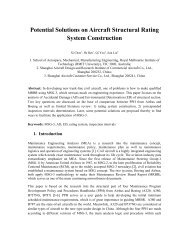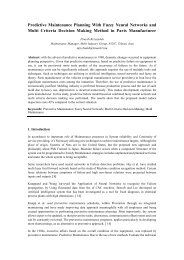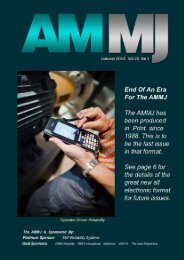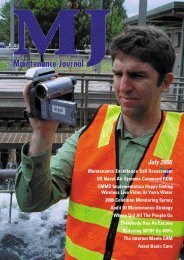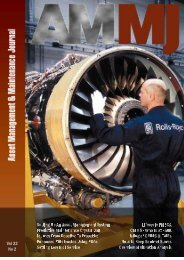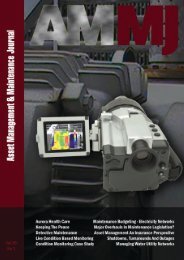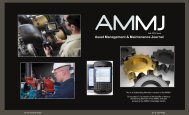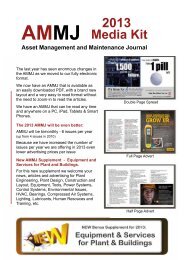July - AMMJ
July - AMMJ
July - AMMJ
Create successful ePaper yourself
Turn your PDF publications into a flip-book with our unique Google optimized e-Paper software.
Effective Thickness of Corroded Steel Plates<br />
43<br />
<strong>AMMJ</strong><br />
1<br />
1<br />
0.8<br />
0.8<br />
( yn / y )<br />
0.6<br />
0.4<br />
Y = 0.204 + 0.795 X<br />
R 2 = 0.911<br />
( bn / b )<br />
0.6<br />
0.4<br />
Y = 0.185 + 0.839 X<br />
R 2 = 0.943<br />
0.2<br />
0.2<br />
0 0.2 0.4 0.6 0.8 1<br />
, (t min / t 0 )<br />
0 0.2 0.4 0.6 0.8 1<br />
, (t min / t 0 )<br />
Figure 7 Relationship of (a) yield stress ratio, (b) tensile stress ratio and minimum thickness ratio ( )<br />
<br />
Considering both yield and tensile stress conditions, it was found that the λ =0.2 gives the best agreement and<br />
hence the representative effective thickness parameter can be defined as:<br />
t eff = 0.2 t 0 + 0.8 t min (8)<br />
Now, the maximum corroded depth (t c,max ) can be expressed as:<br />
t c,max = t 0 - t min (9)<br />
So, considering Eq. 8 and Eq. 9, the following relationship can be obtained for representative effective thickness<br />
(t eff ), which can be used to estimate the remaining yield and tensile strengths of a corroded steel plate.<br />
t eff = t 0 - 0.8 t c,max (10)<br />
A further detailed study comprises with experimental and numerical analysis of more specimens with moderate and<br />
severe corrosion is deemed necessary to understand the significance of this λ value and verify this for different<br />
corrosion levels and environmental conditions.<br />
10<br />
10<br />
( yn / y ) ( bn / b ) <br />
8<br />
(a) Matsumoto et al. 1989<br />
8<br />
(b) Muranaka et al. 1998<br />
t Matsumoto<br />
6<br />
4<br />
t Muranaka<br />
6<br />
4<br />
2<br />
2<br />
Coefficient of Correlation: R 2 = 0.88<br />
0 2 4 6 8 10<br />
t e_b<br />
10<br />
Coefficient of Correlation: R 2 = 0.04<br />
0 2 4 6 8 10<br />
t e_b<br />
10<br />
8<br />
(c) Kariya et al. 2003<br />
8<br />
(d) Proposed<br />
t Kariya<br />
6<br />
4<br />
t eff (Proposed)<br />
6<br />
4<br />
2<br />
Coefficient of Correlation: R 2 = 0.81<br />
2<br />
Coefficient of Correlation: R 2 = 0.90<br />
0 2 4 6 8 10<br />
0 2 4 6 8 10<br />
t e_b<br />
t e_b<br />
Figure 8 Relation between different predicted effective thickness parameters with te_b<br />
Vol 24 No 3




